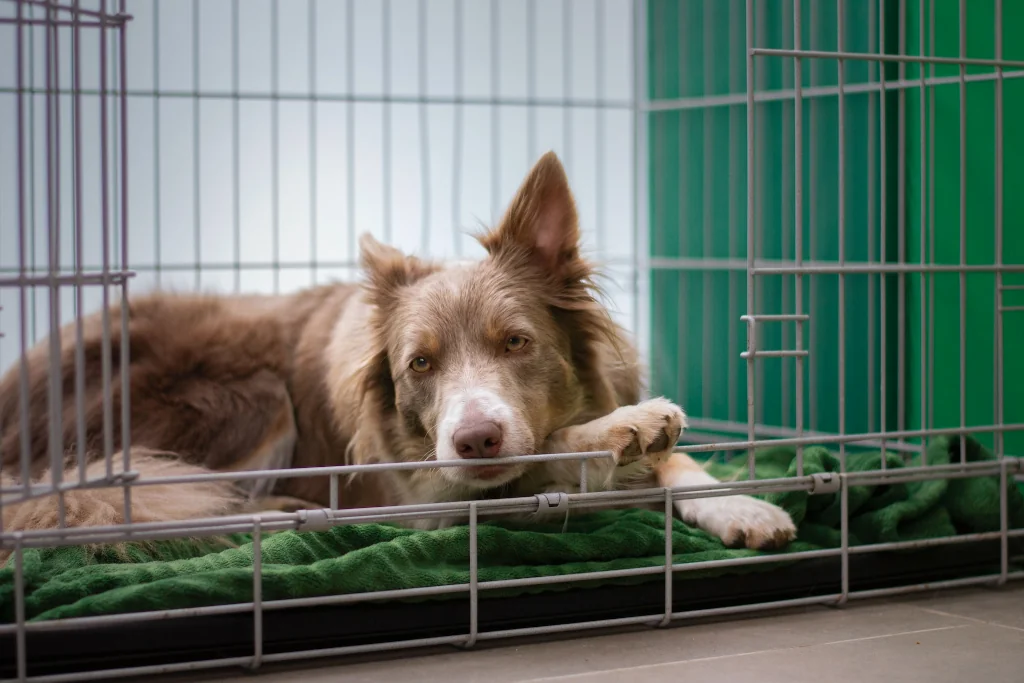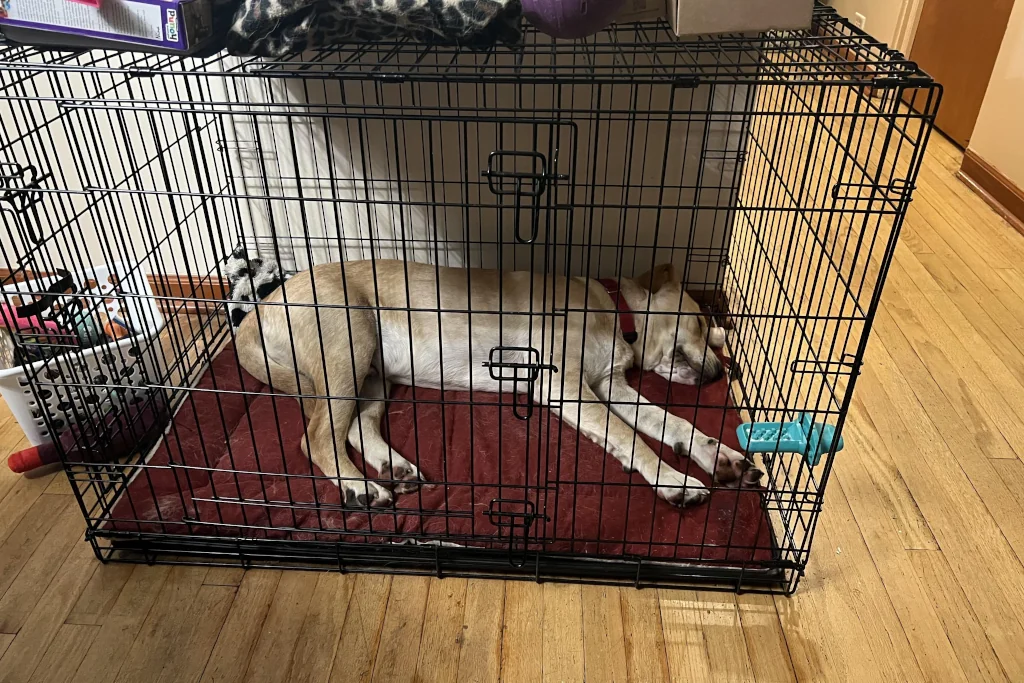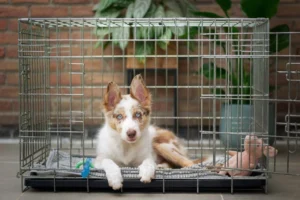Disclosure: We may earn a commission from helpful, relevant links in our content. No cost to you. See our privacy policy.
Let’s talk about crates – those cage-like things you’ve probably seen in pet stores or your friend’s house.
Feel a twinge of unease? You’re not the first. Many dog owners struggle with the concept of crate training, wrestling with questions and guilt: “Isn’t it cruel? Will my dog hate me?”.
Now, take a deep breath. We’re about to shed some light on this misunderstood practice and show you how it could transform your life with your canine companion.

What Is Crate Training and Why Is It Useful?
Crate training, simply put, is teaching your dog to be comfortable in a crate – their very own safe space.
It’s not about confining or punishing, but about creating a personal den for your dog where they can retreat, relax, and feel secure.
Think of it as their personal bedroom, a place where they can snooze peacefully, chew a beloved toy, or simply enjoy a little ‘me’ time. Done right, it can make house training easier, prevent destructive behavior, and even help your pooch handle stressful situations better.
Intrigued? Stick around as we dive deeper into this.
Misconceptions About Crate Training
First, let’s bust some myths.
Misconception one: “Crates are like prison cells.” Not so. Wolves, the ancestors of our domestic dogs, are den animals. They instinctively seek out small, cozy spaces for safety and relaxation. A crate, therefore, can become a den-like sanctuary for your dog with the right training and positive associations.
Second myth: “Crate training is cruel.” On the contrary, a crate offers a safe haven for your dog. It’s important to note that crates should never be used as a form of punishment. Dogs shouldn’t associate their crate with negative experiences.
Finally, the notion that “All dogs hate crates.” Not all dogs will love their crates initially. But with patience, consistency, and positive reinforcement, most dogs can be taught to accept, and even enjoy, their crate.
Shattering these misconceptions is the first step towards a successful crate training journey. Let’s press on and look at the key benefits of crate training, shall we?
Key Benefits of Crate Training Your Dog
Crate training isn’t just a trend – it’s a game-changer if you know how to do it right. Here’s why:
- Safe Travels. A crate-trained dog is easier to transport, whether it’s to the vet, a dog park, or on a family vacation. It keeps them secure and helps alleviate the stress of unfamiliar surroundings.
- Downtime Management. Dogs, just like us, need a break sometimes. A crate gives them a designated spot to retreat and recharge their batteries. It can be especially helpful if you have a high-energy dog who doesn’t know when to stop and rest.
- Damage Control. Puppies and younger dogs are notorious for their ‘destructive phase’. Having a safe, chew-proof space can protect your belongings and also prevent your dog from ingesting something potentially dangerous.
- House Training. A crate can be instrumental in house training, but we’ll dive into that in the next section.
These benefits don’t come from the crate itself, but from using it responsibly and effectively. Remember, a crate is a tool, not a substitute for quality time, exercise, and training.
If you’re looking for the right crate to start your dog’s training, I have a great suggestion. The MidWest iCrate is an excellent choice for new pet parents. It comes in various sizes, includes a divider panel for growing puppies, and even has a removable plastic tray for easy cleaning. So, give your dog a safe space and check out the MidWest iCrate today.

How Can Crate Training Aid House Training?
Now, let’s talk about how crate training and house training go hand in hand.
Dogs are naturally clean animals and prefer not to soil their sleeping areas. This is where the crate becomes useful.
When appropriately sized, the crate encourages your dog to hold their bladder, because it’s just big enough for them to stand, turn around, and lie down, but not so big that they can eliminate in one corner and sleep in another. This helps teach bladder control, a crucial part of house training.
Remember, though, puppies can’t hold their bladder for very long, so regular potty breaks are essential. The general rule of thumb is one hour for every month of age plus one. So, a two-month-old puppy should ideally not be crated for more than three hours at a time without a potty break.
Remember, the crate should never be used to confine your dog for long periods. Used correctly, it can be a positive part of your dog’s life and a great aid in house training. So, let’s see this crate as a tool, and not a punishment.
Our detailed step-by-step guide on how to crate train your dog can show you how. It’s a must-read for all new pet parents aiming for a smooth crate training experience.
Crate Training: A Tool, Not a Punishment
Let me take you back to when I was training my rambunctious puppy, Charlie. Charlie is an adorable Golden Retriever with a knack for turning my living room into his personal chew toy playground. I knew something had to change when I found my favorite pair of shoes chewed beyond recognition.
That’s when I discovered crate training.
With patience and perseverance, we slowly introduced Charlie to his new crate. We made sure it was a positive experience for him, filling it with his favorite soft toys and rewarding him whenever he chose to go in. We used it judiciously, always careful not to overuse it and turn it into a form of punishment.
Soon, the crate became Charlie’s personal haven. When he needed some downtime from his puppy antics or when I needed to ensure his safety, the crate was our go-to solution.
But Charlie was never confined to it for extended periods. It was, and always should be, a tool, not a punishment.
FAQs
How long can a dog stay in a crate during the day?
An adult dog should generally not be crated for more than six hours a day, while puppies, due to their smaller bladders and higher energy levels, need more frequent breaks. Note that this can vary depending on their age and physical needs.
Is it cruel to use a crate for my dog while I’m at work?
Using a crate for your dog while you’re at work isn’t inherently cruel. It’s about how you use it. If you’re gone for long hours, arrange for someone to give them a break or consider a doggy daycare. The crate should be a safe, comfortable space, not a long-term confinement solution.
Can older dogs be crate trained?
Absolutely, older dogs can be crate trained. Like with all training, it requires patience, but older dogs often find the crate to be a comfortable and secure personal space.
Should the crate door always be closed?
The crate door does not always have to be closed. When used correctly, the crate should be a place your dog enjoys, and they should feel free to come and go as they please when it’s appropriate and safe.
Alex, a passionate animal lover, has experience in training and understanding animal behavior. As a proud pet parent to two dogs and three cats, he founded AnimalReport.net to share insights from animal experts and expand his knowledge of the animal kingdom.




